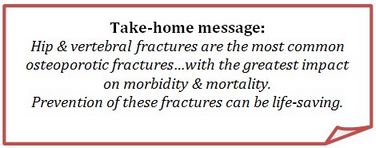Implications of Fractures
3.1.2 Implications of Fractures
As noted previously, the most typical fracture sites in an osteoporotic patient are the hip, wrist and vertebra. Other common sites may also include the following according to recent research27:
| Women | Men |
|---|---|
| Vertebral fractures Hip fractures Wrist-forearm fractures Humeral fractures Other femoral fractures Rib fractures Pelvic fractures Clavicular, scapular, sterna fractures Tibial and fibular fractures | Vertebral fractures Hip fractures Wrist-forearm fractures Humeral fractures Other femoral fractures Rib fractures Pelvic fractures Clavicular, scapular, sterna fractures |
Fractures, regardless of the location, have an impact on our patients in many ways: pain, functional limitations, reduced movement, development of complications (sometimes life-threatening), prolonged impact physically, mentally and socially.
For example, below are the clinical consequences that have been attributed to vertebral fractures42:
| Symptoms | Signs | Function | Future Risks |
|---|---|---|---|
| • Back Pain (acute/chronic) • Sleep Disturbance • Anxiety • Depression • Decreased Self Esteem • Fear of future: • Falls and Fractures • Reduced QOL • Early Satiety | • Height Loss • Kyphosis • Decreased Lumbar Lordosis • Protuberant Abdomen • Reduced Lung F’n • Weight Loss | • Impaired ADL’s • Difficulty Fitting Clothes • Difficulty bending, lifting, descending stairs, cooking | • Increased Risk of Fracture • Increased Risk of Death |
With regards to hip fracture and consequences of morbidity and mortality, the following has been found in the current literature:
- A Canadian study revealed that the risk of death is higher for 5 years after a hip fracture among individuals over the age of 50 years & that hip fractures may induce a progressive health decline25
- Functional sequelae of hip fractures may include: reduced function (mobility, task performance), social function & cognition and affective disorders32
- Hip fractures have a significant impact on health related quality of life (as measured by SF-12), in particular mental and physical components of this measure in older women.6 It has been reported that up to 25% of patients with a hip fracture lose independence and move to long term care in Canada.
